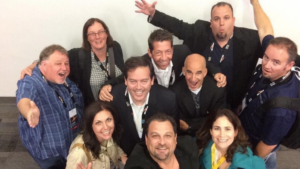You can’t control the things that happen to you. A whole myriad of weird and wonderful stuff is occurring all of the time and you can easily get mixed up in it.
Obviously, there are things within your control – you can make the decision to go to work tomorrow, that’s something you’re controlling. But if you get a pizza thrown at your car by an unknown assailant, it’s not something you planned for or was within your control…ok, I’m hungry now.
Once you take a tongue-in-cheek example like this, you can apply it to how you react to intense or high-emotion situations. Look, you can’t control your immediate, impulsive, internal reaction to something, but you can control your external reaction.
Creating separation between your emotions and the way you perform your identity or take action means that you can acknowledge and feel your emotions, but channel them in a more positive way.
Easier said than done though, right?

Check Your EQ First
Tense conversations and situations can make you feel anxious, fearful, angry, upset…a kaleidoscope of emotions. And this is because our natural instinct is to protect ourselves and fight the idea we need to give something up – this could be your point of view, power, a position to name a few things.
Stressful scenarios cause your body and mind to react, also known as “fight or flight”. You’ll most likely feel very uncomfortable with the natural responses you’re feeling and it makes it much more difficult to make rational decisions or say things you wouldn’t normally.
It is completely possible to intervene and manage your emotions before taking on a witch hunt of emotions. You can also work on ways to examine your thought processes and lead to better external reactions.
Start Here
Being able to acknowledge your feelings and apply them in intelligent ways is the core component of good, healthy emotional intelligence.
- Question your own feelings – Being able to identify the elements of a situation that you find challenging and are struggling with, can help you to manage change better. This is about building your self-awareness skills and asking yourself some probing, tough questions about why exactly you’re feeling the way you’re feeling. A lot of the time, you’ll find that your reactions can be traced back to feelings of fear and inadequacy. What if you can’t succeed in the new environment? Will your skill set be exposed as below-par? Identifying what steps you can take to future-proof your skills and self-esteem is a good way to protect yourself and retain elements of control.
- Get Context First – humans are funny. We sometimes create the worst-case scenarios in our heads. ‘Structural changes at work’ can quickly become OMG, MY WORLD IS CAVING IN. It’s our responsibility to assess the information we have at hand and be sensible with the thoughts we conclude from this. Again, you need to ask yourself what’s behind the feelings you’re instinctively feeling and try to disentangle the personal insecurities that might be driving this. If there are structural changes that will affect your work position, why do you believe you will not be able to succeed there or anywhere else – what’s really driving that emotion? Instead of focusing on the worst-case scenarios, try to see the opportunities for growth. And whatever you do, try to avoid catastrophic prophesizing about your future – 9/10 it’s not accurate.
- Don’t Shutdown, Stay in Relationship – When you’re reacting to a stressful situation, it’s important to acknowledge when you’ve played a part in the build-up. Some people just never do this and think things just miraculously ‘happen’ around them and their actions never contribute to anything, sorry but these people are the worst. No one is perfect and accepting when your behavior and actions have negatively impacted a situation is a part of being a decent human being. It also means that you have the self-awareness to use a situation as a learning moment. When you’re part of a negative chain of events, examine what you’d differently next time and try to positively move on with a broader awareness of yourself.
- Embody Positivity – It’s so easy to write ‘think positive’ and a million times harder to enact and practice. Sometimes the last thing you want to do is try to think about how a shitty situation can ever be positive, but in a lot of work and personal scenarios, there’s a glimmer of hope. Hey, maybe you actually don’t really like your job and changes at work can give you that push and courage you’ve needed for a while to move on. Maybe you can suggest some new responsibilities you’d like to take on if your role is changing. Try to uncover the nuggets of opportunity in a situation, instead of engulfing yourself in a sea of pessimism and negative thoughts…it often feels easier to crack open a bottle of wine and pop a sad playlist on and that’s fine, but after you’ve done it, look for the silver linings.
Final Thoughts
Acknowledging your emotions is super important and opening up and being honest with others can help you to unpick your problems with a situation. But you don’t have to let your emotions completely drive and fuel the actions you take moving forward. You do have control over what you do and say, so if it means taking a second to breathe and count to ten, do it!
Trying to examine why you feel the way you do can help you to take your next steps and protect yourself in uncertain situations. Looking for opportunities and avoiding making split-second, emotional decisions means that when the dust settles, you can take self-aware, honest action.





